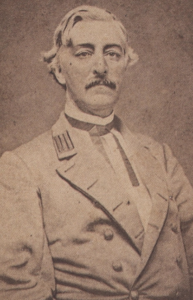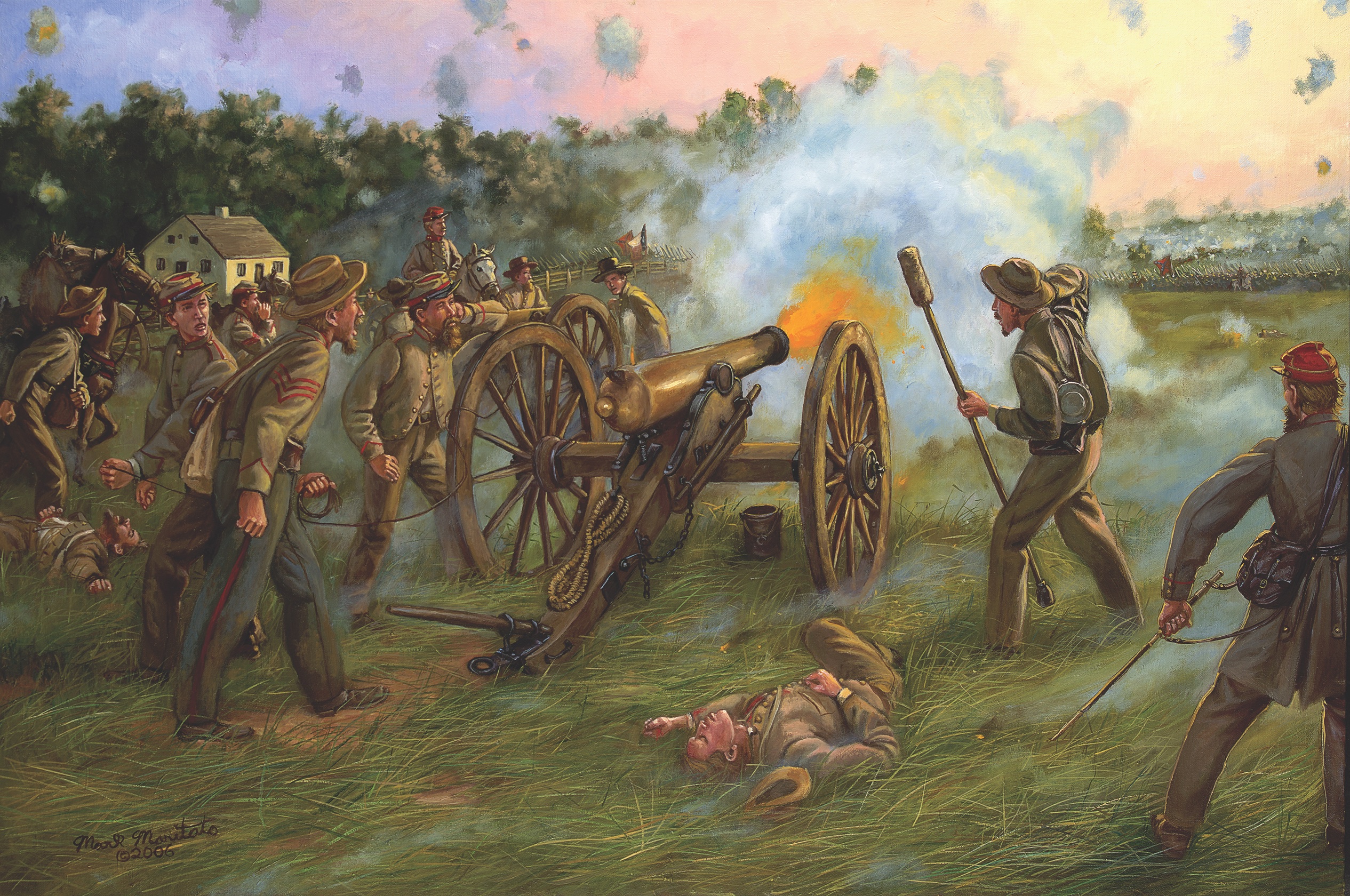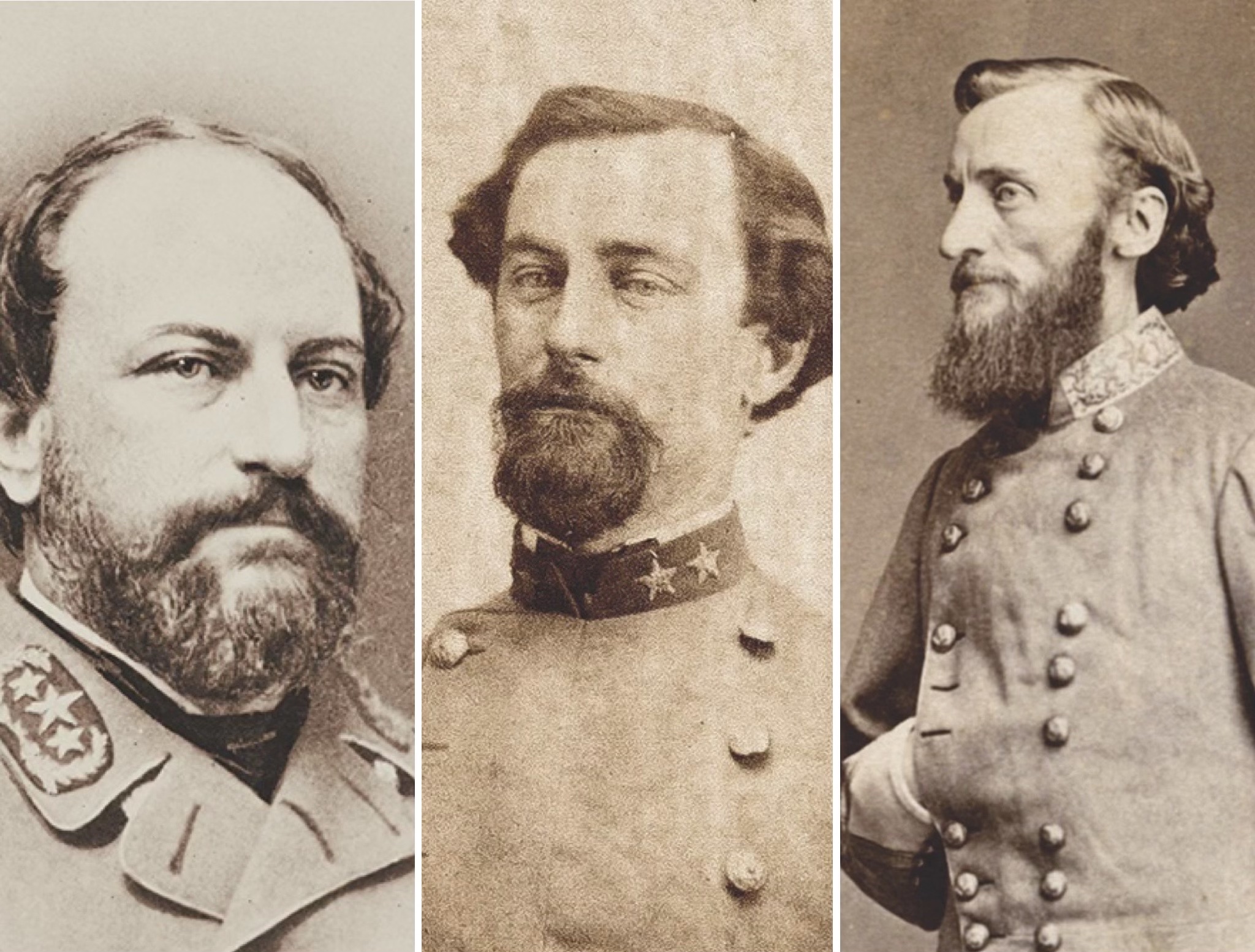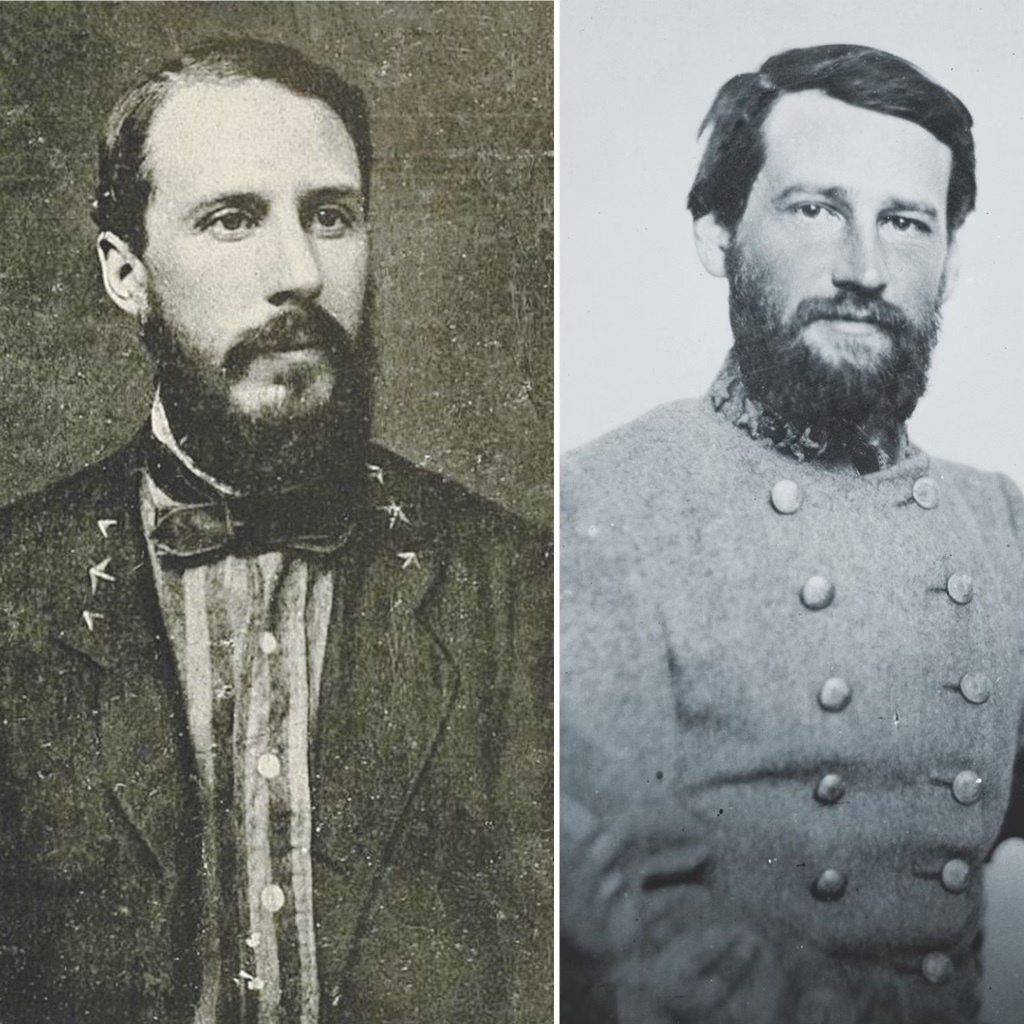
George Vernon Moody, a 26-year-old native of Maine, graduated from the prestigious Harvard Law School in 1842. Degree in hand, he promptly headed to Port Gibson, Miss., to join his younger brother, a successful druggist in the Mississippi River town. The elder Moody secured office space across from the Claiborne County Courthouse and in the almost two decades that followed accrued a reputation as a forceful presence in the courtroom—fiery behavior that at one point provoked six locals enough to attempt to assassinate him. Chased through town, Moody somehow managed to evade their shotgun blasts by racing through several local businesses and churches that lined Port Gibson’s picturesque roadways.
When Mississippi and neighboring Louisiana seceded from the Union in January 1861, the 45-year-old Moody decided to try his hand as a soldier, organizing an infantry company from Port Gibson and parishes across the river in Louisiana. Many of the men who signed up were Irish immigrants who were provided both a bonus for enlisting and a monthly source of income.
Once assembled, the company embarked on a long, winding train ride to Lynchburg, Va., where it was officially mustered into Confederate service. On August 23, Moody’s unit was transferred to the artillery and, in recognition of the men’s Irish roots, took the name Madison (La.) Light Tipperarys Battery. Transferred to the state fairgrounds in Richmond to complete their organization, the “Light Tips,” as they became better known, began training with two 12-pounder howitzers, two 3-inch rifles, and two 6-pounder smoothbores.
Not far away in Hanover and surrounding Virginia counties, another temperamental personality began raising a company of infantry in May 1861: Captain Pichegru Woolfolk Jr., a 6-foot-tall, dark-haired 30-year-old, already regarded as an expert drillmaster. Woolfolk was generally known as “jolly, careless, hospitable, sociable, and always fond of a laugh,” though other characteristics clearly offset his youthful vigor. While “fearless in the face of danger,” he was also “high-strung.“ The captain was also apparently selective with whom he added to his ranks. As one man would write, “I tride to enlist[,] but they told me I was too small and too young.”
Lacking the required number of men for his unit—named the Ashland Light Artillery in July—Woolfolk continued his recruiting efforts until the end of the year. In addition to providing a bounty, he would take each man to a tailor to be fitted for his uniform. The battery achieved sufficient manpower by September but remained underequipped—lacking small arms and harnesses—and in need of more overall training.
Training with the weapons lasted six weeks. In February 1862, Woolfolk’s unit was sent to Manassas Junction, a 75-mile venture that took 10 days because of mud-caked roadways. “[W]ell at that time in Virginia,” a gunner recalled, “it rains a great deal and we [saw] mud worse than any Nebraska mud you ever saw. It was almost impossible to get feed for the men and horses (Sometimes we had to cut down trees about 6 inch through and put them across the mud places so as to get through with the Cannon). We staid at Manassas 2 or three weeks.”

On January 13, 1862, Moody embarked on a 30-day venture to Louisiana and Mississippi to recruit more men for the Light Tips, who had been encamped at Manassas since October 1861. As it was still early in the conflict, Moody’s mission would prove fairly easy, with offers of a $50 bounty particularly enticing to potential recruits. In mid-February, Moody returned to Virginia with 99 officers and men, signed up for the length of the war.
With winter approaching, the soldiers in northern Virginia began constructing small log cabins, complete with fireplaces. It was especially hard for the Louisianans to adjust to the colder temperatures, and each battery’s contingent of horses likewise suffered braving the elements outdoors. Local farmers would occasionally come to the camps to sell goods to the soldiers, which gave the men opportunity to pull shenanigans. “One day there was a man came with a wagon load of dressed Turkeys and chicken,” recalled one Ashland cannoneer, “and when he was selling them at the front end of the wagon the soldiers were stealing them out of the hind end and stole about half his load.”
By April, as the weather got warmer, both the Ashland Light Artillery and Moody’s Battery were assigned to the defenses of Yorktown, Va., as part of Major John J. Garnett’s Artillery Battalion in Maj. Gen. John Bankhead Magruder’s command. This was likely the two captains’ first time serving in close proximity of one another. In the summer of 1862, both units saw their first heavy action during the Seven Days Battles. As one Ashland gunner remembered, “Some times we would get up onto the Breast works and the enemy would fire at us we could see the smoke of there guns before the balls and shells would reach us and Jump down behind the works. [S]ometime the balls would strike the works and cover us all up in dirt. [T]here was the first time I saw a balloon go up in the army it was sent up to see what we were doing we went to work and dug a hole in the ground and let the hind end of the Cannon down got the right elivation and began to fire at them and they soon pulled it down they had a rope to it so that it wouldn’t get away.”
The oldest institution of higher learning in the United States is Harvard University, established in 1636. On September 17, 1862, two Harvard alumni, Confederate Captain George Vernon Moody (Harvard Law School) and Lieutenant William Elliott (Harvard College), found themselves side by side in a field near Sharpsburg, Md., on the bloodiest day of the war. Upon graduating from Harvard, neither man expected to parlay their educations into military careers fighting for an upstart nation. Yet here they were, commanding batteries in Colonel S.D. Lee’s Battalion along the Hagerstown Pike during the Battle of Antietam. The Confederate Army managed to draw 357 former, present, and future Harvard students to fight in its ranks. Granted, a whopping 78 percent of Harvard’s students aligned with the Union, not surprising considering the school’s location in the heart of Massachusetts. Of the number who would don the gray, two achieved the rank of major general: William Henry Fitzhugh “Rooney” Lee (son of Robert E. Lee) and John Sappington Marmaduke. Thirteen former students became brigadier generals: Stephen Elliott Jr.; Martin Witherspoon Gary; Henry Watkins Allen; John Bullock Clark Jr.; John Echols; States Rights Gist; Benjamin Hardin Helm; Albert Gallatin Jenkins; Bradley Tyler Johnson; Alexander Robert Lawton; William Preston; William Booth Taliaferro; and John Rogers Cooke. Allen would become wartime governor of Louisiana and Lawton would be appointed quartermaster general for the Confederacy.

The bravery of the Harvard men in gray was never in question. Of 71 alumni who died while serving during the war, 55 were killed or mortally wounded in action. While Moody and Elliott were engaged along the Hagerstown Pike, two other alumni—Samuel Breck Parkman and Jesse Reed—were struck down in other sectors of the battlefield. On September 18, as the two armies positioned themselves and prepared for a possible resumption of heavy fighting the day after the main battle, Elliott found himself engaged in a “severe fight” from morning until evening, earning praise from his commander for “distinguished gallantry.” Later serving in the Western Theater, he turned in a distinctly heroic effort at Champion Hill, Miss., on May 16, 1863, by grabbing the fallen colors of the 34th Georgia Infantry and carrying them forward. At one point during the subsequent Siege of Vicksburg, Elliott lobbed Parrott shells from his artillery limber like grenades, forcing the Federals to retreat from a ditch they had captured. During the Battle of Bentonville, N.C., in March 1865, Elliott was seriously wounded in the left leg, ending his service. Crimson boys in Confederate gray saw action in all three theaters, enlisting from as old as age 57 (Elias Levy Yulee) to as young as 16 (Julius L. Brown and William Hyslop Sumner Burgwyn). —R.H.H.
Major Garnett complimented the batteries, both attached to Brig. Gen. Robert Toombs’ Brigade during the Seven Days. “Captain Woolfolk,” Garnett reported, “was relieved from duty with General Toombs’ brigade on Monday, July 30, and was engaged only on Friday, [the] 27th, when he behaved very handsomely and his battery did excellent service.” At Garnett’s Farm on June 27, Moody’s Battery served in support of Captain James J. Brown’s Wise (Va.) Artillery. When they opened fire, the Light Tips found themselves fired on by an enfilading Federal battery on the right in addition to the two in front of them. The engagement endured for two hours, but Moody, in such a precarious position, finally retired, incurring only minor losses.
Colonel Stephen D. Lee, the army’s acting chief of artillery, had high praise for Moody’s service. “On June 27, Moody’s and Brown’s batteries engaged the enemy’s works,” he recalled. “I mention the above batteries specifically, as they were each of them under very heavy artillery fire. None of the captains except Brown had their entire batteries; they went into action with their rifle[d guns] section generally. Officers and men behaved well.”
In an after-action report for July 11, Lieutenant James Woolfolk, Pichegru’s brother, noted that his battery had served somewhat uneventfully on picket duty at “Mrs. Price’s property.” In less kind words, Lee complained, “I should like another battery or Woolfolk’s replaced by heavier guns, so I could consider that battery as one of my reserve batteries. Shelling from four enemy batteries opposite on the north s[i]de of the Chickahominy River was ineffective and cause no injury.”
On the 28th, the two rifled pieces of Woolfolk’s unit were detached and accompanied other cannon down the New Bridge Road to shell enemy positions at long range. That gave the Ashland gunners welcome credit “as the enemy broke and ran in every direction.”
In early October, the Hanover (Va.) Artillery, under Captain William Nelson, was disbanded by Special Orders No. 209 and some of its equipment and 40 men transferred to Woolfolk’s command, as were 20 men from the Middlesex (Va.) Artillery—known better as Fleet’s Battery. Many men chose to desert, however, rather than serve in a new command. Others remained absent because of sickness or took unauthorized furloughs. One private even took matters into his own hands and reported to the Amherst Artillery. Woolfolk’s demeanor quite possibly was a reason why so many men avoided serving under his direction.
Although both Moody’s and Woolfolk’s batteries were not engaged at the Second Battle of Manassas in late August, they did see action at Sharpsburg on September 17. On September 14, with Woolfolk’s Battery encamped at Funkstown, Md., two gunners encountered Robert E. Lee while they were out looking for fruit. When the general indicated that their unit would be moving soon, the men scampered back to their command with haversacks full of peaches.
The next day, Woolfolk’s command was ordered to cross the Potomac River at Williamsburg, Md., to guard the fords. Men without shoes were given the option of crossing the river or remaining behind in Virginia to guard the wagons. The bulk of the artillery battalion then crossed Antietam Creek about 8 a.m. Woolfolk’s Battery, equipped with at least one 12-pounder howitzer, and another battery formed part of the Confederate line facing a cornfield from atop a slight rise. On the night of September 16, the entire battalion, except Moody’s unit, was shifted left, bivouacking on the Hagerstown Pike about 400 yards in front of the Dunker Church.
Moody’s men would be integral in the upcoming fray. Equipped with two 3-inch rifles and two 24-pounder howitzers, they had seen action on the 15th. Then early on the morning of September 17, the battery took up a position near the Dunker Church. Colonel Lee ordered Moody to advance 300 yards with two of his guns into a plowed field, where he did “good service” for 15 minutes while “exposed to a most galling infantry fire.”
About 10 a.m., Moody was sent to a nearby ridge, where he quickly refitted his guns and replenished his ammunition before moving adjacent to the famed Washington Artillery of New Orleans in front of the village of Sharpsburg. Moody posted his battery on the right and again “did good service” alongside their fellow Louisiana artillerists, and “repelled some six or eight attempts” by Federal infantry to take “our position.” Colonel Lee later credited Moody “particularly” for “distinguished gallantry.”

Moody drew praise from Brig. Gen. Richard B. Garnett for his aid with his “200 men and two rifled pieces during the Miller Cornfield fighting.” Garnett noted that his infantry held its precarious position “partly due to the brave and energetic manner in which [Moody’s Battery] was handled.” A South Carolina brigade commander also offer commendations for Moody’s “skill, daring and endurance.”
By midday, Moody unlimbered near Brooks’ (S.C.) Artillery, commanded by William Elliott, a fellow Harvard graduate. Moody and the Light Tips played a decisive role in keeping the blue columns pinned down. After Sharpsburg, Colonel Lee rewarded the Light Tips by regularly placing them at the head of his line of march.
When Lee was promoted to brigadier general in November and sent west to command infantry, Moody was among those lobbying for Lt. Col. Edward Porter Alexander, the Army of Northern Virginia’s chief of ordnance, as his replacement. Alexander recalled Moody as “a magnificent specimen of physical manhood, over six feet in height & weighing about 200 pounds, a large strong face, blue eyes and no colored hair. He always dressed well & I think rather prided himself in a carriage & general appearance not unlike Gen. [Robert E.] Lee’s.”
Moody, Alexander noted, was “a good soldier & disciplinarian, & needed to be as his company was rather a rough one, having many ex-stevedores & boat hands from the Mississippi River,” astutely adding: “He & I were always most excellent friends, but he was not an easy man to get along with generally, & was often in more or less hot water with his brother captains.”
Alexander’s observation was certainly on point. Moody’s and Woolfolk’s batteries performed admirably at both Fredericksburg in December 1862 and Chancellorsville in May 1863, but tensions between the two commanders continued to grow. As Alexander recalled, during the march into Pennsylvania in June 1863, “Various little things between Moody and Capt. Woolfolk had kindled feeling.” A few days before the Battle of Gettysburg, Alexander surmised, “some question, of precedence in the march led to a challenge from Moody to Woolfolk” on July 1 at Fairfield outside Gettysburg. Woolfolk accepted the terms for the following day, electing to duel Moody with rifles at 10 paces. That evening, however, orders came to head to Gettysburg. The planned altercation would have to be postponed until after the battle.
Both batteries again exhibited exemplary service during the battle, but fate intervened to permanently postpone the personal dispute. Woolfolk was badly wounded on July 2 and Moody was captured at a later date to prevent a resumption of their affair of honor.
On July 2, during the heavy fighting around the Peach Orchard, the Light Tips adopted the tactic previously used against enemy balloons during the Seven Days. By lowering their guns’ trails into holes in the ground to elevate the barrels, their shots arched when fired. Raining fragments from their exploding shells added to the devastation of the Union soldiers below.
During the night of July 3, 1863, thunderstorms hampered the Confederate retreat from Gettysburg. In the confusion, Moody’s Battery accidentally left behind its flag (shown above). As the 2nd U.S. Cavalry scoured the area, Private Newton McCan recovered the abandoned guidon. On July 4, 1885, the flag was presented to the State of Illinois, where it remained until returned to Louisiana in 2009.
Moody returned to Port Gibson after the war, only to get killed in 1866 when a personal enemy seeking satisfaction fired 16 buckshot into Moody’s back as he sat at his office desk. Four years later, Woolfolk would also lose his life tragically. While attending a trial on the top floor of the Virginia Capitol, he was among several killed when the floor collapsed.
Richard H. Holloway is president of the Civil War Round Table of Central Louisiana.





